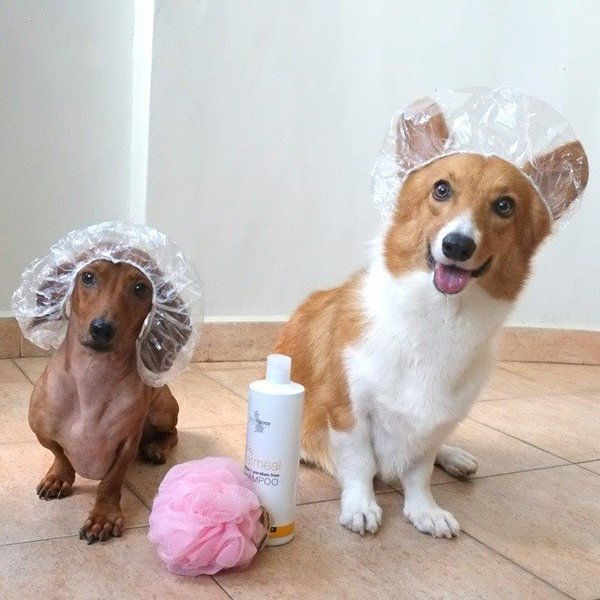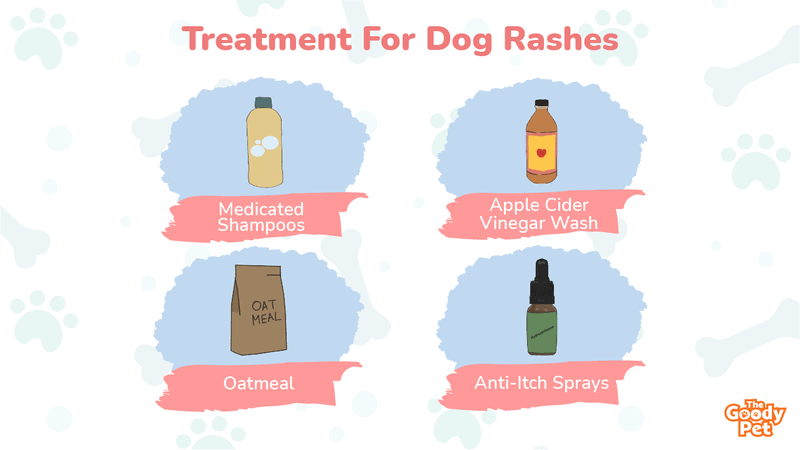All good dog parents hate to see their four-legged best friends in any kind of pain or discomfort. That is why dealing with issues like itchiness and rashes on your dog can be so unnerving. One of the most important things to do when dealing with a pooch that has skin issues like these is to understand the cause of the problem.
Dog rashes appear as a result of a number of health issues. Some are direct and a result of actual skin issues, while others are systemic illnesses with manifestations on the skin. Here is a quick summary of the most important and common causes of dog rashes.
- Allergic dermatitis
- Flea infestation
- Mange
- Skin infections
- Skin cancer
Dog rashes by most of these causes are managed topically using things like topical drugs, medicated shampoos, and some pretty surprising home remedies that you should know about. But before we get into all that, let us take a closer look at the causes of dog rashes and how they may appear.
Why Is My Dog Getting Skin Rashes?

Understanding the cause of skin itchiness and rashes in your dog is the first step to the successful management of the issue. Most people assume that the cause is something like fleas.
And while these parasites are major contributors to skin rashes in dogs, they are not the only culprits. Here are all the reasons your dog may be so itchy even when they don’t have fleas.
Allergic Dermatitis
Dermatitis refers to irritation and inflammation of the skin. In these cases, the inflammation is a result of allergic reactions. Some of the most common triggers in dogs include things like pollen, dust, non-hypoallergenic grooming products, and even some foods.
Dog allergy symptoms typically last about 6 to 24 hours if there is no further exposure to the allergen. The itchiness and rashes may take a further 48 to 72 hours to subside.
Flea Infestation
Just because you cannot see the fleas doesn’t mean they are not there.
If your dog has a lot of rashes and is itching a lot, presumptively managing flea infestation is always a good idea. You have nothing to lose if there are no fleas and everything to gain if the dog is infested by well-hidden bugs.
Mange
There are 2 types of mange caused by different varieties of mites. The parasites burrow under the dog’s skin and cause intense irritation and inflammation. If not promptly managed, mange could cause permanent damage to the dog’s coat.
Skin Infections
Another reason your dog may be having rashes is a result of microorganism infections. This includes bacterial infections, yeast infections, and even worms like ringworms. In these cases, both topical and systemic approaches to management are effective.
Skin Cancer
Skin cancer appears in many different ways, from vague symptoms like redness to ulcerations and projecting growths. Some types of skin cancers in dogs also cause irritation and rashes to form, especially around the affected sites.
What Is The Best Treatment For A Dog With Skin Allergies?

There are many different treatments for skin rashes and irritation. The choice of how to treat your dog rash depends on the possible causes of the actual irritation. Let’s take a look at some of the most effective strategies you could use to put your doggy out of its misery.
Medicated Shampoos
Most causes of skin rashes hide in the skin. It could be allergens like pollen or even parasites like fleas. Whatever the case, a good washing will make all the difference.
Washing the dog also helps ease the irritation, especially if you use cold water. It is also important that you invest in appropriate shampoos.
Medicated shampoos are a great place to start. These include flea shampoos that kill any existing bug and repel those that may have caused reinfestation.
It also includes shampoos with antibacterial and antifungal compounds to deal with and prevent infections on vulnerable skin.
Apple Cider Vinegar Wash
Apple Cider Vinegar is a great weapon to have in your arsenal when dealing with most dog skin issues, especially rashes caused by fleas.
The wash works mainly by getting rid of the triggers, as fleas, ticks, and mites hate the smell of the vinegar. They may also get killed by the acidity the wash creates.
While this is a handy method, it should only be used on intact skin as the vinegar could cause further irritation if used on dogs with open wounds.
Invest In Anti-Itch Sprays
Something else you could give your dog to help deal with skin irritation is anti-itch sprays. Most of these are available over the counter and offer fast relief, especially for localized irritation.
One of the best anti-itch sprays for dogs is the Pet MD Hydrocortisone Spray. It utilizes hydrocortisone as the main active ingredient, which works by countering the immune system’s overreaction to the triggers.
Oatmeal
Another awesome home remedy to help get rid of dog allergy rashes is by using oatmeal. Oatmeal contains proteins that have anti-itch and anti-inflammatory effects for a much-needed soothing effect.
What Can I Give A Dog For Itchy Skin?
In addition to the topical approaches of dealing with itchy dog skin and rashes, there are things that you can give your dog to help soothe them and ease their discomfort. Let’s take a look at some of what they have to offer your furry buddy.
Feed Them Hypoallergenic Dog Food
What most pet owners do not realize is that food plays a huge role when it comes to determining skin health. In fact, many food intolerances result in skin manifestations, including loss of fur and rashes.
It is, therefore, best to get your dog on a hypoallergenic meal plan. Furthermore, ensure that the food is balanced and rich in micronutrients that help with the regulation of the immune system.
Get Your Pooch On A Supplement Regimen
Speaking of micronutrients, supplements are a great way to ensure that your dog gets all they need for a healthy immune system from its diet.
We recommend Zesty Paws Allergy Immune Supplement for dogs sensitive to both food and other environmental triggers. These supplements also contain compounds that promote skin healing and health, including omega oils, EPA, and DHA.
Coconut Oil
Coconut oil works in many different ways when it comes to treating dog skin rashes at home. The oil mainly helps with the restoration of the skin by moisturizing it and promoting natural healing processes.
The best part is that coconut oil can be used both on the skin and through consumption with the same effects. With the latter, 1 teaspoon to 1 tablespoon of coconut oil every day should do the trick.
Try Over-The-Counter Antihistamines
Finally, you could give your dog over-the-counter antihistamines. Most rashes occur as a histamine-mediated response to triggers, whether it is allergies or parasite bites. Antihistamines counter this effect, thus reducing symptoms like inflammation, pain, and itchiness.
We recommend OTC Benadryl Ultratabs Antihistamine Allergy Relief Tablets for their effectiveness and dog-friendly formula.
How Can I Prevent My Dog From Getting Skin Problems?
Prevention is always better than cure, and the same case applies when dealing with dog skin problems. So how do you prevent dermatitis in your pooch? Here are a few strategies that will definitely come in handy.
Keep The Air Clean
Skin allergies are not always from things that your dog gets into skin contact with. Sometimes it is respiratory reactions that trigger skin symptoms like itchiness and rashes. A great example would be allergic reactions to things like pollen and dust.
Keeping the air clean through things like air filters, therefore, goes a long way towards helping you prevent skin problems on your beloved pooch. The Blueair 211+ Air Purifier 3 Stage is ideal for homes with dogs as the pet dander filter feature means the air will also be clean for you.
Keep Floors And Other Surfaces Clean
While we are on this topic of cleanliness as a strategy to deal with dog skin problems, you also have to keep surfaces like your floor clean. This is crucial when dealing with skin rashes as a result of parasite infestation.
Fleas, mites, and ticks tend to drop to the floor with dog dander in different stages from eggs to adults. They later reinfest the dog thus nullifying all your control efforts.
By keeping the floors clean, you will be inhibiting the growth of parasites for a happier and healthier dog. We recommend the iRobot Roomba i3+ with its automated design making this cleaning task way easier.
Take Care Of The Dog’s Gut Health
Gut health is directly linked to immune health and stability. A great way to avoid skin allergies is by boosting your dog’s immunity indirectly by taking care of its digestive system.
Supplements like Zesty Paws Probiotics are perfect for the job. The best part is that their tasty, soft chew formulation makes them easy to administer.
Ensure The Dog Is On A Healthy And Balanced Diet
Finally, you could prevent skin issues in your dog by feeding them a healthy and nutritionally balanced meal.
Pet Plate is definitely worth looking into in this case for something that your dog will not only enjoy but also greatly benefit from. They also customize their meal plans and include hypoallergenic recipes for sensitive dogs.
Can Dogs Get Skin Infections From Groomers? Grooming Tips For Dogs With Rashes
It is highly unlikely for a dog to get a skin infection from professional groomers.
This is because most reputable professionals in the field take extra care and love to prevent cross-contamination between dogs. Their services are also specifically designed to help with the prevention or even treatment of skin issues.
However, if you are still uneasy, you could do most of the grooming yourself. Below is all you need to know about the two most important aspects of grooming a dog with rashes.
Deshed Your Dog Regularly
Deshedding and detangling regularly are important when it comes to controlling skin irritation due to things like fleas and ticks. This is because such parasites take advantage of matting and heavy shedding to hide and multiply.
Your choice of tools here is incredibly crucial. The FURminator Undercoat Tool is perfect for basic brushing and detangling with its strong bristles and self-cleaning mechanism.
You may also have to get yourself a flea comb whose finer bristles help you pick out fleas in all stages of life from the coat.
Wash Your Dog Every 4 To 8 Weeks
Regular washing is also super important when it comes to grooming care for a dog with skin issues.
An interval of 4 to 8 weeks is ideal, depending on the intensity of the issue. Just don’t wash too frequently, as this strips the skin of much-needed protective oils.
You also have to choose the right shampoo for the job. Try Veterinary Formula Clinical Care Antiparasitic & Antiseborrheic Medicated Dog Shampoo. This shampoo is formulated to help soothe irritated skin while also dealing with underlying issues like skin infections and parasite infestations.
Related Questions
Can I Get A Rash From My Dog Licking Me? It is possible to get a rash from your dog licking you. More often than not, this is a result of allergic reactions, as dog saliva contains some of the compounds that trigger allergies in susceptible individuals. The rashes from your dog licking you could also be a sign of infection. This mainly happens if the dog licks you over parts of your skin that are compromised, like cuts and even abrasions.
Can Dogs Cause Skin Rashes On Humans? Dogs can actually cause skin rashes to appear on humans. This is usually a part of systemic allergic reactions to things like pet dander and saliva. Here, the allergies cause general body itchiness that may result in scratches. Another kind of rash you can get from your dog is contagious causes of dermatitis, including Sacroptic mange that is caused by mites.
Can Skin Allergies Kill A Dog? It is possible for skin allergies to kill a dog. One way this could happen is through infections. In this case, intense itchiness results in intense scratching that may break the dog’s skin exposing it to infections. If the infections are serious and unaddressed, they could result in death through sepsis. Another possible cause of death in cases of skin allergies in dogs is anaphylactic shock, but this can be rather rare.





